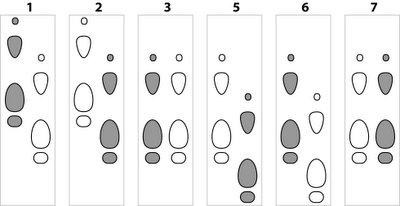November 25, 2005
I have been meaning to write a post for beginner Salsa students for quite some time. This post deals with material that is often covered by beginners class in Cambridge (and probably in many other places).
Figure 1. Basic forward-and-back or Mambo from closed position

Feet movement described below and for all figures is for men/leader.
1 L foot forward
2 weight on R foot in place
3 L foot back together
5 R foot backward
6 weight on L foot in place
7 R foot back (forward) together
In closed position, men (leader) hold women (follower) by a hold similar to Ballroom hold. Leader’s R hand is placed under follower’s L shoulder. Follower’s L hand is placed on top of leader’s R arm. Leader’s L hand holds follower’s R hand without using thumbs – at about follower’s waist level is fine.
Feet shaded in gray have the weight of the body on them. Men’s feet are pointing up, and women’s feet (smaller footprint compared to men’s footprint) are pointing down. Gray rectangle marks the line of dance as used by cross body lead style or LA style.
Leader’s weight is on L foot on 1, 3, and 6 and on R foot on 2, 5 and 7. Follower’s weight is on R foot on 1, 3 and 6 and on L foot on 2, 5 and 7. When dancing Salsa on-1 and not performing shines, aforementioned is true almost all the time. For leaders, Salsa dancing on-1 can be done 100% of the time with the feet rule described above.
Figure 2. Basic forward-and-back or Mambo from open position

1 L foot forward
2 weight on R foot in place
3 L foot back together
5 R foot backward
6 weight on L foot in place
7 R foot back (forward) together
In open position, leader’s R hand holds follower’s L hand and leader’s L hand holds follower’s R hand. Both connections are made at about follower’s waist level. Distance between leader and follower in open hold is larger compared to closed hold position.
Figure 3. Basic back-to-back

1 L foot backward
2 weight on R foot in place
3 L foot back together
5 R foot backward
6 weight on L foot in place
7 R foot back (forward) together
Back-to-back is usually started from open position. For beginner, it may be helpful to note that the hand-to-hand connection is briefly let go or disconnected on the side in which the leader and follower’s feet step backwards. Always start back-to-back step on-1 with leader’s L foot going back and L-R being disconnected. Always end back-to-back step to get back into forward-and-back or Mambo step after reconnecting R-L on 7/8, followed by L foot going forward on 1.
Figure 4. Basic back-to-back with feet and body “opening up”

1 L foot backward
2 weight on R foot in place
3 L foot back together
5 R foot backward
6 weight on L foot in place
7 R foot back (forward) together
In back-to-back basic as done in Figure 3, leader and follower are always facing each other with feet, body and face. In this more “open” back-to-back basic, feet and body of leader and follower face away from each other by up to about 1/4 turn. In this diagram above, body turn is about 1/8 turn.
Figure 5. Men's pivot turn followed by women's pivot turn

1 L foot forward (and turned to right or towards 3’o clock)
2 R foot in place but pointing backwards
3 turn clockwise to face the follower ending with feet together
5 R foot backward
6 weight on L foot in place
7 R foot back (forward) together
In beginner’s class, teachers usually would not ask leaders for a turn during 1,2,3. However, I decided to include it here in part because the mechanics used by leader’s turn during 1,2,3 described here is identical to follower’s turn during 5,6,7. The turns being made here does not need to be a “3’o clock turn” but rather a “12’o clock turn” type, in which L foot forward steps forward without initiating a clockwise turn motion on 1 (for leader) or on 5 (for follower).
No comments:
Post a Comment